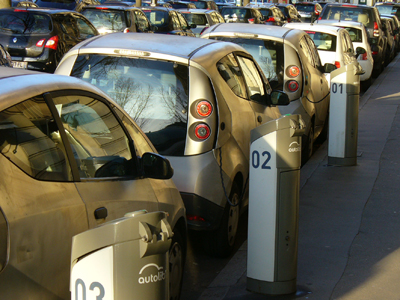Even more than in North America, electric vehicles have become a prominent feature of European streetscapes, as this Paris scene shows. (Photo: Greg Klein)
It’s the mining and exploration world’s hottest commodity, with parabolic prices amid a rush to find new sources of supply. But can lithium sustain this level of enthusiasm? Consider the collapse of uranium in 2007, rare earths in 2011, graphite in 2012 and—in this case, most foreboding—lithium itself between 2009 and 2011. Is this time different? Or should we heed a cautionary tale?
“We live in very exciting times in terms of how energy is used, generated and stored, and lithium is at the epicentre of that,” says Chris Berry. As an analyst with House Mountain Partners and the Disruptive Discoveries Journal, he examines the interplay of technology, emerging economies and commodities, especially energy minerals. “The demand story, when you look at the forecasts for electric vehicles and energy storage in particular, is real. It’s defensible and it’s sound.” Yet lessons from the past can’t be ignored, he adds.
“The lithium story in 2009 was almost the same as it is today: ‘Electric vehicles are here.’ In other words, they were considered ready to compete,” he recalls. “But that wasn’t the case. In 2009 they could not compete on a cost basis with internal combustion engines. I think the main difference now is the absolute collapse in cost of a lithium-ion battery on a per-kilowatt-hour basis. Now, because lithium-ion battery prices fall by about 14% per year, we are getting to the point where vehicle electrification can take hold.”
Although battery costs did drop in 2009, “on a per-kilowatt-hour basis the average battery was much more expensive than it is today.” This time around, “batteries continue to get cheaper and they continue to get more powerful at the same time. That’s a winning combination.”
Variable oil and gas prices play a role too. “But when you look at the broad trend, battery prices are falling.”
Berry’s forecasts might be less bullish than others, but remain optimistic. “There are predictions that EVs will be 20% to 25% of the overall vehicle fleet by 2025. I think that if full electric vehicles, plug-ins and hybrids made up 5% to 7% of the global fleet by 2025, that would be a huge win for the lithium market in particular and for the electric vehicle movement as well.”
Meeting demand brings on the challenges of “making a discovery, getting it permitted and ultimately building a mine,” Berry notes. “I see a tight lithium market over the next three or four years, although not anything where demand is going to blow supply away. But you can’t forget some of the lessons of the past where niche metal prices went crazy, a huge flock of juniors went into the space and a lot of capital was misallocated and lost. You have to think about the difference between investing and speculating.”

Chris Berry: “The main difference now is the absolute collapse in cost of a lithium-ion battery on a per-kilowatt-hour basis.”
On issues of electrification, much media attention focuses on one company and its charismatic, tremendously accomplished founder. So could the boom go bust should that firm experience setbacks or, God forbid, Elon Musk get run over by a diesel-burning bus?
“Vehicle electrification really is a Tesla-centric story right now,” Berry acknowledges. “But I think the focus on Tesla is misguided. When you look at the automotive landscape you’ve got so many other automotive companies electrifying their vehicle fleets to varying degrees over the next three to five to seven years. I credit Tesla with making people realize that vehicle electrification can work. But focusing on that one company is very short-sighted.”
Nor will Tesla’s Gigafactory be the planet’s sole battery-building behemoth. At least 12 such factories are expected to come online by 2020, according to Benchmark Mineral Intelligence. Another recent reports ays Volkswagen’s considering joining the group.
Berry also emphasizes the importance of a “huge, existing lithium-ion battery supply chain” that continues to grow as companies like Panasonic, Samsung SDI and LG Chem expand their capacity.
But what are the chances of a rival technology taking over? “In the next five to 10 years, absolutely zero,” Berry responds. “To be fair, there are many other chemistries out there. But lithium-ion has been around for 30 years, it’s been commercially used safely since 1991, it’s been scaled up and mass-produced. So a lot of the R&D and technology is really focused on lithium-ion right now. It would take at least five to 10 years for any of these other chemistries to catch up with and supplant lithium-ion.”
Ultimately different battery chemistries will be used for different needs, for example long-distance driving versus energy storage, he adds. “But lithium-ion is the clear frontrunner and I do not expect that to change in the next five to 10 years.”
Having said that, he sees lithium’s price eventually settling back from its steep ascent. “But I think lithium prices will remain higher than they had been for the previous 18 to 24 months,” Berry says. “And that has to do with that really tight market for supply right now.”
Chris Berry addresses the Vancouver Commodity Forum on June 14. Click here for free registration.
Read more at the original source: http://resourceclips.com/2016/05/27/lithium-boom-or-bubble/

